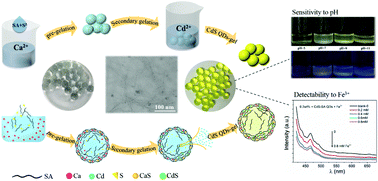Preparing CdS QDs in sodium alginate gel: realizing water solubility and stimuli responsiveness of QDs in an integrative way†
Abstract
Quantum dots (QDs) are of great interest due to their excellent fluorescence properties and thus, they have been widely studied. Compared with the typical organometallic synthetic routes and hydrothermal methods usually carried out under high temperatures, methods employing colloidal templates can be used for preparing QDs in mild conditions and have gained increasing attention. In this prospect, a hydrogel is an ideal colloidal template for the preparation of QDs in an aqueous medium, while the related study for in situ preparation of QDs in a gel and the consequent functionalization of QDs are in demand. In this paper, we proposed a two-step method to prepare CdS QDs in a sodium alginate (SA) gel, which showed effective constraint in the uniform size distribution of QDs. Without the introduction of additional ligands, the prepared CdS–SA QDs exhibited responsiveness to pH and detection of Fe3+, thus providing a simplified way for the functionalization of QDs. CdS–SA QDs showed good biocompatibility and stability in a certain concentration, which indicated the prospective applications of CdS–SA QDs in the fields of biological labeling and environmental sensing.



 Please wait while we load your content...
Please wait while we load your content...